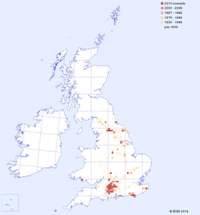The Burnt Orchid has suffered a massive decline in the past 50 years due to habitat loss and destruction. In Wales there is only one site where it still occurs, and it is hanging on in around 70 managed sites around the UK. Neotinea ustulata is classified as endangered on the Red List of threatened orchids in the UK. Its specific habitat requirements of unimproved chalk grassland has been the cause of its downfall as modern agricultural practice, reliant on herbicide and pesticide chemicals, has replaced traditional farming methods. Until recently the Burnt Orchid was placed in the Orchis genus, but recent scientific study has revealed that it has more in common with Neotinea orchids and so it has been moved into the Neotinea genus along with Neotinea maculata (formerly Orchis intacta). The common name 'burnt' refers to the appearance of the flowerhead when in bud: the flowers open from the bottom upwards and the buds on the upper part, which are a rich dark maroon, remain tightly closed, giving the impression of a singed tip. The Lady Orchid Orchis purpurea is similar when in bud but is a much more robust plant. Burnt Orchids do not all flower at the same time and, as a result, are sometimes considered as being two varieties, although there is little scientific evidence to support this. Neotinea ustulata var. ustulata is the more common and flowers in late May and June, whereas Neotinea ustulata var. aestivalis (occuring in southern England) flowers in July. The Burnt Orchid's range is confined to Europe, where it grows in Scandinavian countries and southwards towards the Mediterranean. In southern Europe this orchid is mainly confined to mountains, and it does not occur in the Mediterranean lowlands.
| Distribution Map | Key Features | |
 |
Records for the Burnt Orchid from BSBI are shown on the map with most recent in front. (Hover the mouse over the small map to expand it.) |
Plant: very variable in height and ranging from 2.5cm to 30cm although plants are most frequently up to 15cm tall. |
Image Gallery for Burnt Orchid Neotinea ustulata
| Pollination | Taxonomy & Hybrids |
Very little is known, but the earlier flowering Burnt Orchids appear to be pollinated by small flies which are probably attracted by the colour and scent of the flowers, since the plant does not produce nectar with which to reward pollinators. |
The Burnt Orchid belonged, until recently, to the genus Orchis, but recent genetic studies have revealed that it (and the Dense-flowered Orchid Neotinea maculata formerly Orchis intacta) are more closely related to the Neotinea orchids and so they have been moved in the Neotinea genus. |
Articles about Burnt Orchid in JHOS
